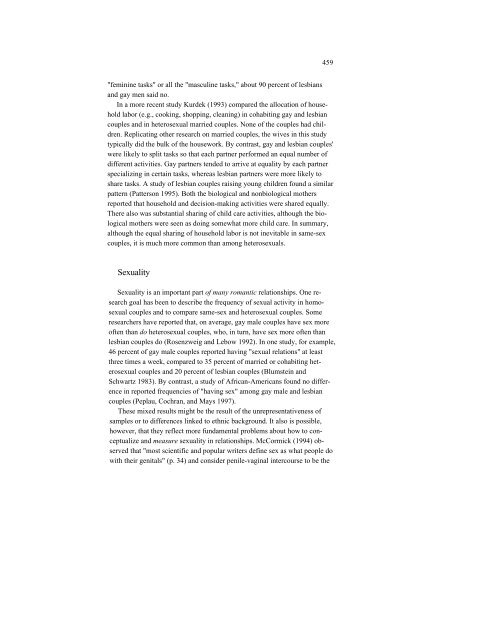17 The Close Relationships of Lesbians, Gay Men, and Bisexuals
17 The Close Relationships of Lesbians, Gay Men, and Bisexuals
17 The Close Relationships of Lesbians, Gay Men, and Bisexuals
Create successful ePaper yourself
Turn your PDF publications into a flip-book with our unique Google optimized e-Paper software.
459<br />
"feminine tasks" or all the "masculine tasks," about 90 percent <strong>of</strong> lesbians<br />
<strong>and</strong> gay men said no.<br />
In a more recent study Kurdek (1993) compared the allocation <strong>of</strong> house-<br />
hold labor (e.g., cooking, shopping, cleaning) in cohabiting gay <strong>and</strong> lesbian<br />
couples <strong>and</strong> in heterosexual married couples. None <strong>of</strong> the couples had chil-<br />
dren. Replicating other research on married couples, the wives in this study<br />
typically did the bulk <strong>of</strong> the housework. By contrast, gay <strong>and</strong> lesbian couples'<br />
were likely to split tasks so that each partner performed an equal number <strong>of</strong><br />
different activities. <strong>Gay</strong> partners tended to arrive at equality by each partner<br />
specializing in certain tasks, whereas lesbian partners were more likely to<br />
share tasks. A study <strong>of</strong> lesbian couples raising young children found a similar<br />
pattern (Patterson 1995). Both the biological <strong>and</strong> nonbiological mothers<br />
reported that household <strong>and</strong> decision-making activities were shared equally.<br />
<strong>The</strong>re also was substantial sharing <strong>of</strong> child care activities, although the bio-<br />
logical mothers were seen as doing somewhat more child care. In summary,<br />
although the equal sharing <strong>of</strong> household labor is not inevitable in same-sex<br />
couples, it is much more common than among heterosexuals.<br />
Sexuality<br />
Sexuality is an important part <strong>of</strong> many romantic relationships. One re-<br />
search goal has been to describe the frequency <strong>of</strong> sexual activity in homo-<br />
sexual couples <strong>and</strong> to compare same-sex <strong>and</strong> heterosexual couples. Some<br />
researchers have reported that, on average, gay male couples have sex more<br />
<strong>of</strong>ten than do heterosexual couples, who, in turn, have sex more <strong>of</strong>ten than<br />
lesbian couples do (Rosenzweig <strong>and</strong> Lebow 1992). In one study, for example,<br />
46 percent <strong>of</strong> gay male couples reported having "sexual relations" at least<br />
three times a week, compared to 35 percent <strong>of</strong> married or cohabiting het-<br />
erosexual couples <strong>and</strong> 20 percent <strong>of</strong> lesbian couples (Blumstein <strong>and</strong><br />
Schwartz 1983). By contrast, a study <strong>of</strong> African-Americans found no differ-<br />
ence in reported frequencies <strong>of</strong> "having sex" among gay male <strong>and</strong> lesbian<br />
couples (Peplau, Cochran, <strong>and</strong> Mays 1997).<br />
<strong>The</strong>se mixed results might be the result <strong>of</strong> the unrepresentativeness <strong>of</strong><br />
samples or to differences linked to ethnic background. It also is possible,<br />
however, that they reflect more fundamental problems about how to con-<br />
ceptualize <strong>and</strong> measure sexuality in relationships. McCormick (1994) ob-<br />
served that "most scientific <strong>and</strong> popular writers define sex as what people do<br />
with their genitals" (p. 34) <strong>and</strong> consider penile-vaginal intercourse to be the
















